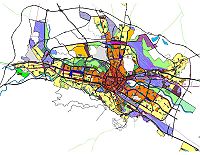
Photo from wikipedia
Although Weber’s law is the most firmly established regularity in sensation, no principled way has been identified to choose between its many proposed explanations. We investigated Weber’s law by training… Click to show full abstract
Although Weber’s law is the most firmly established regularity in sensation, no principled way has been identified to choose between its many proposed explanations. We investigated Weber’s law by training rats to discriminate the relative intensity of sounds at the two ears at various absolute levels. These experiments revealed the existence of a psychophysical regularity, which we term time–intensity equivalence in discrimination (TIED), describing how reaction times change as a function of absolute level. The TIED enables the mathematical specification of the computational basis of Weber’s law, placing strict requirements on how stimulus intensity is encoded in the stochastic activity of sensory neurons and revealing that discriminative choices must be based on bounded exact accumulation of evidence. We further demonstrate that this mechanism is not only necessary for the TIED to hold but is also sufficient to provide a virtually complete quantitative description of the behavior of the rats.Using data from rats and humans, the authors study the time it takes to make sensory judgments. The authors define the new regularity as the time–intensity equivalence in discrimination (TIED), which provides a mechanistic basis of Weber’s law.
Journal Title: Nature Neuroscience
Year Published: 2019
Link to full text (if available)
Share on Social Media: Sign Up to like & get
recommendations!